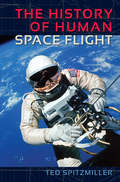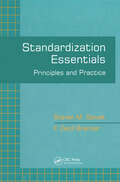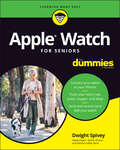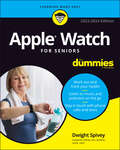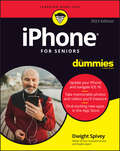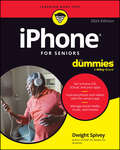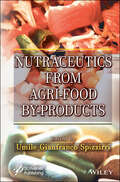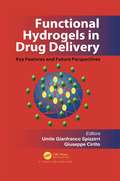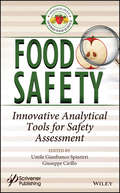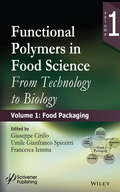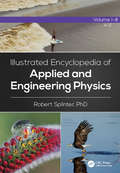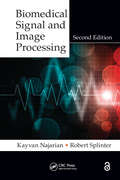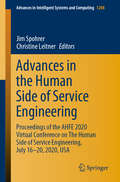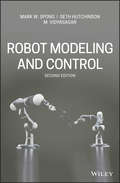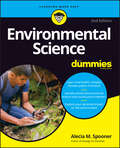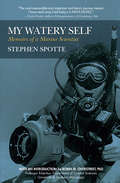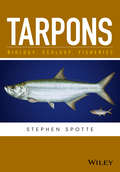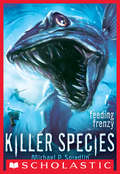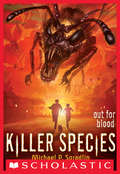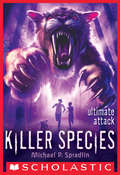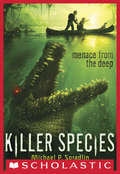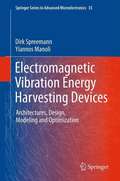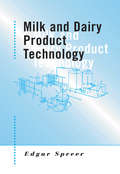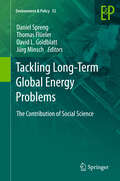- Table View
- List View
The History of Human Space Flight
by Ted Spitzmiller“A very competent, complete history of manned spacecraft. . . . A strongly recommended resource.”—Choice "A fascinating human saga of dedication, competition, sacrifice, and achievement."--Dave Finley, National Radio Astronomy Observatory "An ambitious and thorough history, extending back to the earliest risk takers and innovators who laid the groundwork for the astronauts and cosmonauts who would break the bonds of Earth."--George Leopold, author of Calculated Risk "Brings many of the personalities in the exploration of space to life. Spitzmiller offers a great perspective on issues from Von Braun's involvement with the Nazi Party to Grissom's infamous hatch."--Sidney M. Gutierrez, former NASA shuttle commander "A wonderfully synthetic and penetrating account of humankind's historic ventures into space."--James R. Hansen, author of First Man "A well-researched space history full of little-known details that all space enthusiasts will want."--Marianne J. Dyson, author of A Passion for Space Highlighting men and women across the globe who have dedicated themselves to pushing the limits of space exploration, this book surveys the programs, technological advancements, medical equipment, and automated systems that have made space travel possible. Beginning with the invention of balloons that lifted early explorers into the stratosphere, Ted Spitzmiller describes how humans first came to employ lifting gasses such as hydrogen and helium. He traces the influence of science fiction writers on the development of rocket science, looks at the role of rocket societies in the early twentieth century, and discusses the use of rockets in World War II warfare. Spitzmiller considers the engineering and space medicine advances that finally enabled humans to fly beyond the earth's atmosphere during the space race between the United States and the Soviet Union. He recreates the excitement felt around the world as Yuri Gagarin and John Glenn completed their first orbital flights. He recounts triumphs and tragedies, such as Neil Armstrong's "one small step" and the Challenger and Columbia disasters. The story continues with the development of the International Space Station, NASA's interest in asteroids and Mars, and the emergence of China as a major player in the space arena. Spitzmiller shows the impact of space flight on human history and speculates on the future of exploration beyond our current understandings of physics and the known boundaries of time and space.
Standardization Essentials: Principles and Practice
by Steven M. Spivak F. Cecil BrennerThis ready reference surveys the discipline of standards and standardization, defining common terms, clarifying descriptions, describing how standards could be used to restrain trade, and explaining how international trade is stimulated by the due process provisions of standards writing organizations. Containing real-world examples provided by experienced standards professionals, Standardization Essentials is a vital, forward-looking reference for mechanical, civil, electrical and electronics, materials, chemical, mineral, cost, quality, reliability, industrial, developmental, safety, forensic, and consulting engineers; standards managers; architects; project managers; upper-level undergraduate, graduate, and continuing education students in these disciplines.Crystallizes the essential role that standards play in strategic standardization management, purchasing, contractual agreements, and international trade!Covering costs, benefits, limitations, uses, and abuses of standardization programs, Standardization Essentials Considers whether standards build or bar trade and the use of international standards to leverage world markets Presents a case study of conformity assessment related to international technical trade barriers Focuses on consumer safety standards for automobile tires and other products Addresses implementation of ISO 9000 and ISO 14000 management system standards in industry Highlights voluntary (nongovernmental) and mandatory (governmental) standards and regulations developed by a variety of organizations Reveals competition, incongruities, and harmonization among national and international standards
Apple Watch For Seniors For Dummies
by Dwight SpiveyHey, Siri! How do I get up to speed with this amazing watch? If you’re a proud owner of an Apple Watch, you’re in luck. These handy little devices can change the way you keep track of your health, stay in touch with friends and family, and even get around. It’s got apps for just about everything you can think of! But how do you go about getting acquainted with such a powerful tool? With Apple Watch For Seniors For Dummies, of course. This book will walk you through the aspects of owning and using an Apple Watch you’ll apply in your daily life, from taking it out of the box for the very first time to counting the calories you burned on your latest walk. This super-simple guide shows you how to: Connect your Apple Watch to your other devices, like a Mac computer or an iPhone Send messages to—and receive messages from—friends and relatives by email, text, or voice Make your watch look exactly the way you want it to with custom Apple Watch faces Whether you just got an Apple Watch as a gift or you’ve had one for a while and you’re looking to unlock even more cool features and capabilities, Apple Watch For Seniors For Dummies is your from-scratch guide to getting the most out of one of the most functional smartwatches on the market today.
Apple Watch For Seniors For Dummies
by Dwight SpiveyAll the info you want about Apple Watch, and none of the fluff you don’t Apple Watch For Seniors For Dummies helps you get the most out of your smart device. Start with the very basics if you’re an Apple Watch newbie, or, if you’re upgrading, check out the no-nonsense coverage of the latest bells and whistles. The upgraded Sleep app, Afib monitoring that you can share with your doctor, the new Medications app for logging prescriptions, and, of course, all the texting, weather, and fitness features Apple users love. This book is packed with all the information you need to get up to speed on the latest versions of the Apple Watch and watchOS 9. For users in the 60+ crowd, this For Seniors guide uses a larger font for text and a larger size for figures to make the book as easy to read as possible. You’ll also find Tips, Warnings, and Notes to help you stay safe while you make the most out of your watch and avoid common mistakes. Yep, it’s a computer for your wrist. Let this friendly guide show you all it can do. Take a simple, step-by-step approach to getting started with Apple Watch Select the right watch model for your needs and link it to your iPhone or Mac Send text messages, receive calls, and keep track of your health—from your wrist Learn the ins and outs of the latest models for 2023-2024Interested in keeping up with the latest technology trends? Get on board the Apple Watch train, thanks to this handy resource.
iPhone For Seniors For Dummies: Updated For Iphone 12 Models And Ios 14
by Dwight SpiveyLearn your way around iOS 16 and the latest iPhone models iPhone For Seniors For Dummies is the perfect guide for seniors who want to use the iPhone to make calls, send and receive text messages, check e-mail, and FaceTime with loved ones. With its larger font size, crystal-clear figures and drawings, and content on senior-friendly apps of all kinds, this book is accessible and tailored specifically to fit the needs of the 50+ crew. The possibilities of your smart phone are nearly endless, and, with the help of Dummies, you&’ll discovery just how much this pocket-sized computer can do. Set up your new phone, take great photos and videos, secure your data, and stay safe online. Update your iPhone and navigate iOS 16 Customize your phone and find exciting new apps Snap memorable photos and record videos you'll treasure Connect on social media and make video callsThis is an excellent Dummies guide for older iPhone users who need to understand the basics of the apps and functions they&’ll use every day.
iPhone For Seniors For Dummies
by Dwight SpiveyThe perfect guide for staying connected with your new iPhone iPhone For Seniors For Dummies is a no-nonsense manual for making the most of the latest iPhone models. You’ll learn how to navigate your device’s software and customize its settings for your needs. Plow through the basics like making calls, sending text messages, checking your e-mail, using FaceTime, tracking your health, and beyond. The step-by-step instructions are right here. With the help of this clear and accessible Dummies guide, you’ll set up your phone and discover all the neat features it has to offer. Start taking great photos with the iPhone’s legendary camera, check the weather, download games and other apps. You’ll also learn how to keep your phone safe, secure, and up to date—no worries. Choose the right iPhone for you, set up your phone, and start calling and texting Learn to make video calls with Facetime and share photos and videos on social media Discover apps and utilities that can make your life easier Play games, browse the internet, and watch movies on your iPhoneWith larger print, clear figures, and senior-focused content, this book is perfect for iPhone users who just need the basics explained without the fluff.
Nutraceutics from Agri-Food By-Products
by Umile Gianfranco SpizzirriNUTRACEUTICS FROM AGRI-FOOD BY-PRODUCTS This book represents a comprehensive and unique overview covering different aspects (raw materials, technological innovations, and potential applications) concerning waste and by-products of the food industry. Wastes and by-products of the agri-food chain represent a rich source of active molecules that can be usefully employed in the food and pharmaceutical industries. Eco-friendly extraction procedures able to isolate the different components of the agri-food by-products represent an attractive challenge to increase the waste’s value, and, at the same time, solve the issues usually related to their disposal. Each of the 12 chapters in Nutraceutics from Agri-Food By-Products deeply analyses a specific agri-food chain, highlighting the main components recovered in the processing of food, seafood, and dairy wastes and by-products. Specifically, a green approach to the extraction of active molecules is described, as well as the industrial application of agri-food wastes and by-products, and their chemical, physical, and biological properties. Such properties are suitable for use in the food, cosmetic, and pharmaceutical fields. This circular approach could be usefully employed in the industry to develop and commercialize new nutraceuticals and/or functional food that guarantee a considerable increase in the economic worth of the wastes, while producing beneficial effects on human health. Audience Food technologists and biotechnologists in research and industry as well as researchers in pharmaceutical sciences.
Functional Hydrogels in Drug Delivery: Key Features and Future Perspectives
by Umile Gianfranco Spizzirri Giuseppe CirilloThe book deals with the synthesis and characterization of hydrogels specifically used as drug delivery systems. Each chapter includes the most recent updates about the different starting materials employed and the improvement of their physicochemical and biological properties to synthetize high performing carriers for specific uses.
Food Safety: Innovative Analytical Tools for Safety Assessment
by Umile Gianfranco Spizzirri Giuseppe CrilloFood safety and quality are key objectives for food scientists and industries all over the world. To achieve this goal, several analytical techniques (based on both destructive detection and nondestructive detection) have been proposed to fit the government regulations. The book aims to cover all the analytical aspects of the food quality and safety assessment. For this purpose, the volume describes the most relevant techniques employed for the determination of the major food components (e.g. protein, polysaccharides, lipds, vitamins, etc.), with peculiar attention to the recent development in the field. Furthermore, the evaluation of the risk associated with food consumption is performed by exploring the recent advances in the detection of the key food contaminants (e.g. biogenic amines, pesticides, toxins, etc.). Chapters tackle such subject as: GMO Analysis Methods in Food Current Analytical Techniques for the Analysis of Food Lipids Analytical Methods for the Analysis of Sweeteners in Food Analytical Methods for Pesticides Detection in Foodstuffs Food and Viral Contamination Application of Biosensors to Food Analysis
Functional Polymers in Food Science
by Umile Gianfranco Spizzirri Francesca Iemma Giuseppe CrilloPolymers are an important part in everyday life; products made from polymers range from sophisticated articles, such as biomaterials, to aerospace materials. One of the reasons for the great popularity exhibited by polymers is their ease of processing. Polymer properties can be tailored to meet specific needs by varying the "atomic composition" of the repeat structure, by varying molecular weight and by the incorporation (via covalent and non-covalent interactions) of an enormous range of compounds to impart specific activities. In food science, the use of polymeric materials is widely explored, from both an engineering and a nutraceutical point of view. Regarding the engineering application, researchers have discovered the most suitable materials for intelligent packaging which preserves the food quality and prolongs the shelf-life of the products. Furthermore, in agriculture, specific functionalized polymers are used to increase the efficiency of treatments and reduce the environmental pollution. In the nutraceutical field, because consumers are increasingly conscious of the relationship between diet and health, the consumption of high quality foods has been growing continuously. Different compounds (e.g. high quality proteins, lipids and polysaccharides) are well known to contribute to the enhancement of human health by different mechanisms, reducing the risk of cardiovascular disease, coronary disease, and hypertension. This first volume, of this two volume book, concerns the application of polymers in food packaging.
Illustrated Encyclopedia of Applied and Engineering Physics, Three-Volume Set
by Robert SplinterThis resource provides a single, concise reference containing terms and expressions used in the study, practice, and application of physical sciences. The reader will be able to identify quickly critical information about professional jargon, important people, and events. The encyclopedia gives self-contained definitions with essentials regarding the meaning of technical terms and their usage, as well as about important people within various fields of physics and engineering, with highlights of technical and practical aspects related to cross-functional integration. It will be indispensable for anyone working on applications in biomedicine, materials science, chemical engineering, electrical engineering, mechanical engineering, geology, astronomy, and energy. It also includes handy tables and chronological timelines organized by subject area and giving an overview on the historical development of ideas and discovery.
Biomedical Signal and Image Processing
by Robert Splinter Kayvan NajarianWritten for senior-level and first year graduate students in biomedical signal and image processing, this book describes fundamental signal and image processing techniques that are used to process biomedical information. The book also discusses application of these techniques in the processing of some of the main biomedical signals and images, such as EEG, ECG, MRI, and CT. New features of this edition include the technical updating of each chapter along with the addition of many more examples, the majority of which are MATLAB based.
Advances in the Human Side of Service Engineering: Proceedings of the AHFE 2020 Virtual Conference on The Human Side of Service Engineering, July 16-20, 2020, USA (Advances in Intelligent Systems and Computing #1208)
by Jim Spohrer Christine LeitnerThis book reports on cutting-edge research and best practices in developing innovative service systems. It covers issues concerning the suitability of a given system for human use, human services, and excellent human experiences. It explores a wide range of ways in which human factors in engineering, ergonomics, human–computer interaction (HCI), cognitive engineering, and many other disciplines can contribute to the design and management of service systems. It considers aspects related to cost effectiveness, ethics, and privacy, among others, and covers applications in many areas, from healthcare to education, transportation, and the economy. Based on the AHFE 2020 Virtual Conference on the Human Side of Service Engineering, held on July 16–20, 2020, the book provides readers with a comprehensive overview of current research and future challenges in the field of service engineering, together with practical insights into the development of innovative services for various kinds of organizations.
Robot Modeling and Control
by Mark W. Spong Seth Hutchinson M. VidyasagarA New Edition Featuring Case Studies and Examples of the Fundamentals of Robot Kinematics, Dynamics, and Control In the 2nd Edition of Robot Modeling and Control, students will cover the theoretical fundamentals and the latest technological advances in robot kinematics. With so much advancement in technology, from robotics to motion planning, society can implement more powerful and dynamic algorithms than ever before. This in-depth reference guide educates readers in four distinct parts; the first two serve as a guide to the fundamentals of robotics and motion control, while the last two dive more in-depth into control theory and nonlinear system analysis. With the new edition, readers gain access to new case studies and thoroughly researched information covering topics such as: ● Motion-planning, collision avoidance, trajectory optimization, and control of robots ● Popular topics within the robotics industry and how they apply to various technologies ● An expanded set of examples, simulations, problems, and case studies ● Open-ended suggestions for students to apply the knowledge to real-life situations A four-part reference essential for both undergraduate and graduate students, Robot Modeling and Control serves as a foundation for a solid education in robotics and motion planning.
Environmental Science For Dummies
by Alecia M. SpoonerAce your environmental science class and get smart about the environment Environmental Science For Dummies is a straightforward guide to the interrelationships of the natural world and the role that humans play in the environment. This book tracks to a typical introductory environmental science curriculum at the college level—and is great as a supplement or study guide for AP Environmental Science, too. Uncover fascinating facts about the earth’s natural resources and the problems that arise when resources like air, water, and soil are contaminated by pollutants. If you’re in need of extra help for a class, considering a career in environmental science, or simply care about our planet and want to learn more about helping the environment, this friendly Dummies resource is a great place to start. The key concepts of environmental science, clearly explained All about the changing climate, including new understanding of methane release in the arctic Earth’s natural resources and the importance of protecting them A new chapter on environmental justice, where issues of poverty and sustainability intersectA solid foundation in environmental science is essential for anyone looking for a career in the field—and is important knowledge for all of us as we work together to build a sustainable future.
My Watery Self
by Stephen SpotteIn MY WATERY SELF: AN AQUATIC MEMOIR, author/scientist Stephen Spotte traces a fascinating trail through a life that began in West Virgina coal camps, drifted through reckless bohemian times of countercultural indulgence in Beach Haven, New Jersey, and led to a career as a highly-respected marine biologist. Together, these stories form a view not just of one man's life, but that of a generation that often refused to take a direct path to the workplace, insisting instead on a winding unveiling of true self-realization, to achieve previously-unimagined outcomes. For Spotte, the key was water: His years of beach living led to a self-initiated study of literature and the sea. He eventually returned to college and received his training as a marine biologist, and discovered, through his singular voice, a wet and occasionally very weird perspective on the world. His writing is engrossing throughout, the stories he shares--such as his stint as curator of the New York Aquarium at Coney Island at the tail end of the hippie era--are compelling and thoroughly enjoyable as he elevates the people and situations he encounters to mythical levels, blending empirical observation with literary prose.
Tarpons: Biology, Ecology, Fisheries
by Stephen SpotteStephen Spotte, Mote Marine Laboratory, Sarasota, Florida, USA Tarpons arose from an ancient lineage, and just two species exist today, confined to the tropics and subtropics: Megalops atlanticus in the western and eastern Atlantic and Megalops cyprinoides distributed widely across the Indo-West Pacific. The Atlantic tarpon is considered king of the saltwater sport fishes and supports a multi-billion dollar recreational fishery in the U.S. alone. The Pacific tarpon, which is much smaller, is less valued by anglers. Both have limited commercial value but offer considerable potential for future aquaculture because of their hardiness, rapid growth, and ease of adaptation to captivity. This book is the latest and most thorough text on the biology, ecology, and fisheries (sport and commercial) of tarpons. The chapters comprise clear, intricate discourses on such subjects as early development and metamorphosis, population genetics, anatomical and physiological features and adaptations, migrations, reproductive biology, and culminate with a concise overview of the world's tarpon fisheries. A comprehensive appendix includes Spotte's original translations of important papers published previously by others in Spanish and Portuguese and unavailable until now to English readers. Tarpons: Biology, Ecology, Fisheries will be of considerable interest and use to fishery and research biologists, marine conservationists, aquaculturists, and informed anglers
Killer Species #2: Feeding Frenzy (Killer Species #2)
by Michael P. SpradlinA brand-new action-packed series from Michael P. Spradlin. Each book covers a genetically engineered super-predator wreaking havoc on the environment. Time has passed since anyone's heard from Dr. Catalyst. Emmet and Calvin have even begun to think that the crazed scientist might be gone for good. But then, on a trip to snorkel off the Florida coast, one of their friends is nearly drowned by an underwater monster, with endless rows of razor-sharp teeth. No one is quite sure what they saw. Was it a moray eel? A giant barracuda? There's only one thing Emmet knows for certain. Dr. Catalyst is back. And this time, he's out for revenge.
Killer Species #3: Out for Blood (Killer Species #3)
by Michael P. SpradlinThe action-packed series by Michael P. Spradlin returns. Each book covers a genetically engineered superpredator wreacking havoc on the environment. Dr. Catalyst has finally come unhinged. Twice the crazed scientist has released his super predators into the wild to combat invasive species, and twice Emmet Doyle and his best friend Calvin Geaux have exploded his efforts. Now he's out for something more than just snakes and fish. Dr. Catalyst wants revenge. It's a quiet night when Emmet takes his dog, Apollo, out for a walk in the backyard. Until the noise begins. Part batlike screech, part insect buzz -- it seems to be coming from the roof. Suddenly the sky is full of dark, beating shapes, and they're all headed straight for Emmet. Dr. Catalyst's newest creations are hungry, and only one thing will satisfy them. Blood.
Killer Species #4: Ultimate Attack (Killer Species #4)
by Michael P. SpradlinThe action-packed series by Michael P. Spradlin returns. Each book covers a genetically engineered superpredator wreacking havoc on the environment. It's all come to this. Dr. Catalyst has had enough of Emmet Doyle's meddling. Time after time, Emmet and his friend Calvin Geaux have stepped in to ruin his plans, just when he'd released one of his genetically engineered killer species into the Florida environment. This time, Dr. Catalyst is releasing his most deadly creation yet. It's a terrifying lone hunter, bred to stalk and destroy one specific target -- Emmet Doyle.
Menace From the Deep (Killer Species #1)
by Michael P. SpradlinA brand-new action-packed series from Michael P. Spradlin. Each book covers a genetically engineered super predator wreaking havoc on the environment. Emmet Doyle is not in the best mood when he arrives in Florida City. His father is a wildlife biologist, and has been summoned to the Everglades, dragging Emmet along with him. Though still in mourning from losing his mom a year ago, Emmet's trying hard to keep a good attitude. Upon their arrival, however, things quickly get weird. Dr. Rosalita Geaux, the Park Superintendent, wastes no time in revealing the reason she called Emmet's father to Florida. A strange creature was recently found dead in the park, and upon seeing it, it becomes clear to everyone that this is not a native species. This is man-made. Deep in the swamp, someone has been experimenting to create a new breed of apex predator. And they're about to set them loose.
Electromagnetic Vibration Energy Harvesting Devices
by Dirk Spreemann Yiannos ManoliElectromagnetic vibration transducers are seen as an effective way of harvesting ambient energy for the supply of sensor monitoring systems. Different electromagnetic coupling architectures have been employed but no comprehensive comparison with respect to their output performance has been carried out up to now. Electromagnetic Vibration Energy Harvesting Devices introduces an optimization approach which is applied to determine optimal dimensions of the components (magnet, coil and back iron). Eight different commonly applied coupling architectures are investigated. The results show that correct dimensions are of great significance for maximizing the efficiency of the energy conversion. A comparison yields the architectures with the best output performance capability which should be preferably employed in applications. A prototype development is used to demonstrate how the optimization calculations can be integrated into the design-flow. Electromagnetic Vibration Energy Harvesting Devices targets the designer of electromagnetic vibration transducers who wishes to have a greater in-depth understanding for maximizing the output performance.
Electromagnetic Vibration Energy Harvesting Devices: Architectures, Design, Modeling and Optimization (Springer Series in Advanced Microelectronics #35)
by Dirk Spreemann Yiannos ManoliElectromagnetic vibration transducers are seen as an effective way of harvesting ambient energy for the supply of sensor monitoring systems. Different electromagnetic coupling architectures have been employed but no comprehensive comparison with respect to their output performance has been carried out up to now. Electromagnetic Vibration Energy Harvesting Devices introduces an optimization approach which is applied to determine optimal dimensions of the components (magnet, coil and back iron). Eight different commonly applied coupling architectures are investigated. The results show that correct dimensions are of great significance for maximizing the efficiency of the energy conversion. A comparison yields the architectures with the best output performance capability which should be preferably employed in applications. A prototype development is used to demonstrate how the optimization calculations can be integrated into the design–flow. Electromagnetic Vibration Energy Harvesting Devices targets the designer of electromagnetic vibration transducers who wishes to have a greater in-depth understanding for maximizing the output performance.
Milk and Dairy Product Technology (Food Science And Technology Ser. #83)
by Edgar SpreerAddressing both theoretical and practical issues in dairy technology, this work offers coverage of the basic knowledge and scientific advances in the production of milk and milk-based products. It examines energy supply and electricity refrigeration, water and waste-water treatment, cleaning and disinfection, hygiene, and occupational safety in dairies.
Tackling Long-Term Global Energy Problems: The Contribution of Social Science
by Daniel Spreng Thomas Flüeler David L. Goldblatt Jürg MinschThis book makes a case for a multidisciplinary and transdisciplinary approach to energy research--one that brings more of the social sciences to bear. Featuring eight studies from across the spectrum of the social sciences, each applying multiple disciplines to one or more energy-related problems, the book demonstrates the strong analytical and policy-making potential of such a broadened perspective. Case studies include: energy transitions of households in developing countries, the 'curse of oil', politics and visions for renewables, economics and ethics in emissions trading, and carbon capture and storage.
